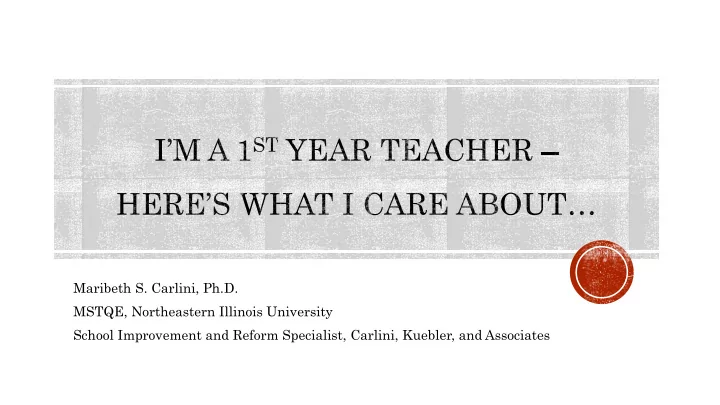

Maribeth S. Carlini, Ph.D. MSTQE, Northeastern Illinois University School Improvement and Reform Specialist, Carlini, Kuebler, and Associates
Work k Force ce Traditi tiona nalists sts, , 10% 10% Gen Y, , 15% 15% Traditionalists Baby Boomers Gen X Gen X, , 30% 30% Gen Y Baby Boomer omers, , 45% 45%
Born after 1981 Self-directed Innovative Eager to participate in decision-making Motivated to effect the greater good Favor inclusive style of management Desire immediate feedback Socially conscious Global in though
14% of new teachers leave by the end of 1 st year 33% of teachers leave within 3 years 59% of teachers leave by the end of the 5 th year (Wieblke & Bardin, 2009) st year Cost Break ak-Down Down of 1 st ar Mentorin ntoring and Induc uction ion Prog ogram Number of Mentors 20 Number of Mentees 43 Mentor Pay ($5,707/mentor) $114,140 Mentor Pay for New Teacher Week ($35/hour * 6 hours * 5 days * 20) $21,000 ½ Day Sub Pay for Mentors and Mentees at $100/day $28,350 Guest Speakers $5000 TOTAL COST $168,49 ,490
Fr Frequ quency ency of In Interaction eraction with th Co Coach, ch, Mentor ntor, or Mast ster er Teacher cher Several times a week 38.1% Once a week 28.8% Once a month 14.7% Once every couple months 7.9% I did not have a coach or 10.5% mentor Total 100%
Illinois Professional Teaching Standards – more than 80% of respondents answered either mostly or completely for all standards. Value-added questions: Access to school or district expense for PD Common planning time Supportive communication with supervisor
AN ANOVA: used to determine what effect, if any, the coaches, mentors, and/or master teachers had on 1 st year teachers understanding of Professional Teaching Standards. Factor tor Analysi ysis: used to identify factors that explain common variance amongst variables. Statistical method of grouping together to measure a common construct. Linea ear r Regre gression ssion: this was used to determine if there was a correlation between the effectiveness of mentors and coaches and the three factors and the number of years teachers planned to stay in the field.
AN ANOVA: No effect. Fa Factor tor An Analys ysis is: The three main themes that emerged – 1. Collaboration 2. Meeting student needs through providing appropriate instruction 3. Additional access to support Linear ar Re Regressi ession on: If teachers are exposed to the three factors, they will remain in the profession for a longer time.
Residency Program: “Residency is the difference between being a medical school graduate and a doctor.” Multiple supervisors Cohort model Develop self-confidence, collection of materials, experience Competence Embraced by veterans who can share knowledge
Retired Teacher-led Mentor Cohort Contract successful retired teachers Cohort Model Doesn’t have to be content -specific – focus on emotional support Competence of veterans Embraced by veterans who can share knowledge Cost-effective
Revise current Mentoring Program – Evaluate honestly the program Apply Academic Return on Investment (A-ROI) model to ALL programs Use veteran/retired teachers as on-site substitutes Retired Teacher-led Mentor Cohort Title I and IIA funds
Develop teachers through collaboration Allow release time for new teachers to observe veteran teachers Full-time mentors available for mentees Use of technology to build a new teacher community with teachers around the state, country, and world Capitalize on what Generation Y brings to the table and what they crave Provide emotional support and feedback as well as instructional.
Contact information: Maribeth S. Carlini, Ph.D. carliniandkuebler@gmail.com 847/962-4347
Recommend
More recommend